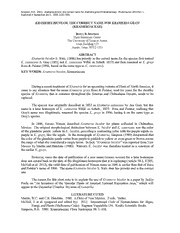
Krameria bicolor, the correct name for Krameria grayi (Krameriaceae) PDF
Preview Krameria bicolor, the correct name for Krameria grayi (Krameriaceae)
Simpson, B.B. 2013. Krameha bicolor, the correct name for Krameha gray! {Kv^&\^c&^€}. Phytoneuron 2013-62: 1. Published 4 September 2013. ISSI^ 2153 733X KRAMERIA BICOLOR, THE CORRECT NAME FOR KRAMERIA GRAYI (KRAMERIACEAE) Beryl Simpson B. Plant Resources Center The University of Texas at Austin Main Building 127 Austin, Texas 78712-1711 ABSTRACT Krameria hicolor S. Wats. (1886) has priority as the correct name for the species frrst named A K. canescens Gray (1852, not K. canescens Willd. ex Schult. 1827) and then renamed as K. grayi & Rose Painter (1906, based on the same type as K. canescens). KEY WORDS: Krameria Krameriaceae bicolor, During a recent treatment of Krameria for an upcoming volume of Flora of North America, it & my came to attention that the name Krameria grayi Rose Painter, used for years for the shrubby common species of Krameria that throughout the Sonoran and Chihuahuan Deserts, needs to be is replaced. The species was originally described in 1852 as Krameria canescens by Asa Gray, but this name is a later homonym of K. canescens Willd. ex Schult., 1827. Rose and Painter, realizing that Gray's name was illegitimate, renamed the species K. grayi in 1906, basing on the same type as it Grray's species. In 1886, Sereno Watson described Krameria bicolor for plants collected in Chihuahua, Mexico. The original morphological distinction between K. hicolor and K. canescens was the color of the glandular petals: yellow in K. bicolor, providing a contrasting color with the purple sepals vs. purple in K. grayi, like the sepals. In the monograph of Krameria, Simpson (1989) determined that the color of the glandular petals varies from purple to pinkish to yellow or even green or brown across New the range of what she considered a single taxon. In fact, ^Krameria hicolof^ was reported from Mexico by Martin and Hutchins (1980). Watson's K. bicolor was therefore treated as a synonym of the earher K. grayi. However, since the date of publication of a new name (nomen novum) for a later homonym does not extend back to the date of the illegitimate homonym that replacing (Article 58. ICBN, it is 1, McNeil et al. 20 12), the valid date of publication of Watson name in 1 886 is earlier than that of Ros e and Painter's name of 1906. The name Krameria bicolor S. Wats, thus has priority and is the correct The reason for this short note is to explain the use of Krameria bicolor in a paper by Jackie Poole on "An Inventory of the Vascular Plants of Amistad National Recreation Area," which will appear in the December (Number 16) issue of Lundellia. LITERATURE CITED WC. New Martin, and C.R. Hutchins. 1980. AFlora of Mexico. 2 vols. Vaduz. McNeil, J. et al. (prepared and edited by). 20 12. International Code of Nomenclature for Algae, Regnum Fungi, and Plants (Melbourne Code). Vegetabile 154. Koeltz Scientific Books. Simpson, B.B. 1989. Krameriaceae. Flora Neotropica 98: 1-108.
